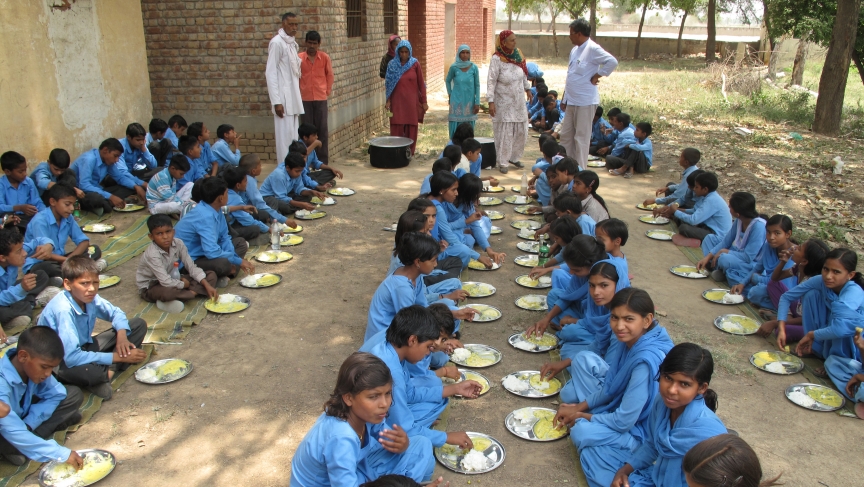Lesson Plan August 11, 2015
A Free Meal: India's School Lunch Program
Country:
Grades:
Questions for "Power Lunch Animation: India's Mid-Day Meal Program"
- What are the main points the artists wish to communicate?
- How do the artists convey their message? What specific design or visual elements do they use to convey the lives of schoolchildren in India?
- The artists relied on the reporting of Rhitu Chatterjee to create the animation. What other research do you think they did before creating the animation?
Questions for "India: Here’s Why Kids—and Parents—Love the Country's School Lunch Program"
- What happened to Indian schoolchildren during their mid-day meal program on July 16, 2013?
- What did journalist Rhitu Chatterjee discover when she investigated the free lunch program in Bawani Khera?
- What is the impact of the free lunch program according to the Young Lives study and economist Jean Dreze?
India's School Lunch Program Not Only Fights Hunger—It Can Breed Tolerance
Resource 3:
1. Research and discuss the caste system in India. Who are the Dalits or Untouchables?
2. Discuss the effects of the school lunch program on caste discrimination.
Questions for "India's School Lunch Program Imperfect, But Deserves Credit for Feeding Millions"
- Discuss the nutritional benefits of the school lunch program. What are other benefits and shortcomings?
- Compare and contrast India's mid-day meal program to lunch programs in the United States. How do programs in the U.S. meet health and nutritional needs? What are regional differences in the programs? How are local resources used?
- Digging deeper: What are other countries where school lunch programs are most effective? What makes them successful? What areas need improvement?
Questions for "India's Free School Lunches Can Fight — or Reinforce — Caste Discrimination in India"
- Give examples of caste-based discrimination that takes place in the free lunch program.
- Explain why 22 children in eastern Uttar Pradesh dropped out of school.
- Research and discuss drop-out rates in the United States. What are the causes for high drop-out rates in U.S. schools? What can be done to improve the situation?
Questions for "School-Lunch Program Provides Unexpected Benefits for Rural Indian Women"
- Describe the benefits of the school lunch program for poor and marginalized women.
- What happened to Saroj in the first 10 years of her marriage? When did she get her first big break?
- How is Saroj now influencing the lives of other women?
- Research the effect of domestic abuse in your community. What resources are available to women who are suffering from domestic abuse?
To Learn More
"A Free Meal: India's School Lunch Program"
This link will take you to a project summary with additional resources.
This lesson is written as a series of notes for the facilitator. A series of questions on the resources for students is attached.
India's midday meal program is the largest free lunch school program in the world. It feeds 120 million schoolchildren and employs 2 million women.
In a series of articles and radio reports journalist Rhitu Chatterjee discusses the program's impact on nutrition, school attendance, employment opportunities for poor or marginalized women who serve as cooks, and the effect on reducing discrimination by allowing children of different castes to eat together. Both shortcomings and benefits of the program are discussed.
A lively and colorful animation produced by Mathilde Dratwa reinforces key points in the reporting.
Introducing the Lesson:
Share the animation (Resource 1) with your students and discuss (see questions for Resource 1).
Read, Listen, Discuss:
Select 2 or three other resources. Ask students to read or listen to the reports and then answer questions related to each resource.
Optional: Provide students with the additional material listed under Resources.
Wrapping Up and Digging Deeper:
1. Compare and contrast India's mid-day meal program to lunch programs in the United States. How do programs in the U.S. meet health and nutritional needs? What are regional differences in the programs? How are local resources used?
2. What are other countries where school lunch programs are most effective? What makes them successful? What areas need improvement?












